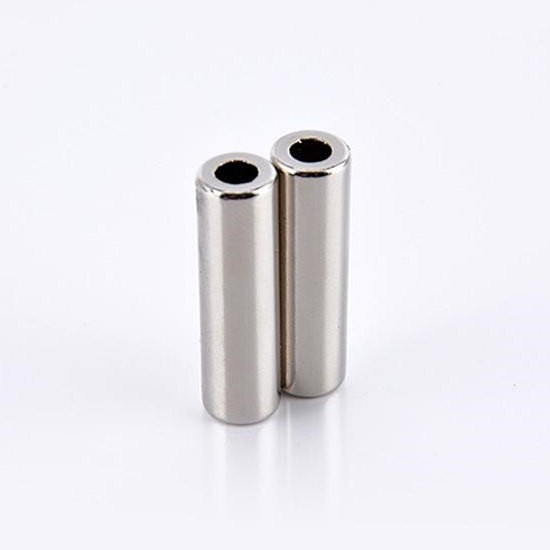What is the maximum temperature a cylindrical magnet can withstand?
 Oct 21, 2025|
Oct 21, 2025| As a supplier of cylindrical magnets, I often receive inquiries from customers about the maximum temperature these magnets can withstand. This is a crucial question, as understanding the temperature limits of cylindrical magnets is essential for their proper application in various industries. In this blog post, I will delve into the factors that determine the maximum temperature tolerance of cylindrical magnets, the different types of cylindrical magnets and their temperature capabilities, and the implications of exceeding these temperature limits.
Factors Affecting the Maximum Temperature Tolerance of Cylindrical Magnets
The maximum temperature a cylindrical magnet can withstand is influenced by several factors, including the material composition of the magnet, its crystal structure, and the manufacturing process. Different magnet materials have different Curie temperatures, which is the temperature at which a magnetic material loses its permanent magnetic properties. For cylindrical magnets, the most common materials are neodymium, samarium cobalt, alnico, and ferrite, each with its own unique temperature characteristics.
Neodymium magnets, known for their high magnetic strength, have a relatively low Curie temperature compared to other magnet materials. Typically, the Curie temperature of neodymium magnets ranges from 310°C to 400°C. However, the maximum operating temperature, which is the temperature at which the magnet can maintain its magnetic properties without significant degradation, is much lower, usually between 80°C and 200°C, depending on the grade of the neodymium magnet.
Samarium cobalt magnets, on the other hand, have a much higher Curie temperature, ranging from 700°C to 800°C. This makes them suitable for high-temperature applications where neodymium magnets would lose their magnetic properties. Samarium cobalt magnets can operate at temperatures up to 300°C or even higher, depending on the specific grade.
Alnico magnets have a Curie temperature of around 800°C and can operate at high temperatures without significant loss of magnetic strength. They are often used in applications where high-temperature stability is required, such as in aerospace and automotive industries.
Ferrite magnets have a relatively low Curie temperature compared to samarium cobalt and alnico magnets, typically around 450°C. However, they are more resistant to demagnetization at high temperatures compared to neodymium magnets. Ferrite magnets can operate at temperatures up to 250°C, making them suitable for applications where cost-effectiveness and moderate temperature resistance are important.
In addition to the material composition, the crystal structure of the magnet also plays a role in determining its temperature tolerance. Magnets with a more ordered crystal structure are generally more stable at high temperatures. The manufacturing process can also affect the temperature resistance of the magnet. For example, magnets that are sintered at higher temperatures tend to have better temperature stability.
Different Types of Cylindrical Magnets and Their Temperature Capabilities
There are several types of cylindrical magnets available in the market, each with its own temperature capabilities.
Hollow Cylinder Magnets: These magnets are commonly used in applications where weight reduction is important, such as in robotics and aerospace. Hollow cylinder magnets can be made from different materials, including neodymium, samarium cobalt, and ferrite. The temperature tolerance of hollow cylinder magnets depends on the material used. For neodymium hollow cylinder magnets, the maximum operating temperature is typically between 80°C and 200°C, while samarium cobalt hollow cylinder magnets can operate at temperatures up to 300°C or higher. You can find more information about Hollow Cylinder Magnets.
Cylindrical Permanent Magnets: These magnets are widely used in various applications, including motors, generators, and magnetic separators. Cylindrical permanent magnets can be made from different materials, with neodymium and ferrite being the most common. Neodymium cylindrical permanent magnets have a maximum operating temperature of 80°C - 200°C, while ferrite cylindrical permanent magnets can operate at temperatures up to 250°C. For more details on Cylindrical Permanent Magnet.
Cylinder Shape Magnets: These magnets are available in different sizes and grades, and can be used in a wide range of applications, from consumer electronics to industrial machinery. The temperature tolerance of cylinder shape magnets depends on the material and grade. Neodymium cylinder shape magnets have a limited temperature range, while samarium cobalt and alnico cylinder shape magnets can withstand higher temperatures. Check out Cylinder Shape Magnet for more options.
Implications of Exceeding the Maximum Temperature
Exceeding the maximum temperature that a cylindrical magnet can withstand can have several negative implications. When a magnet is exposed to temperatures above its maximum operating temperature, it can experience a phenomenon called thermal demagnetization. This occurs when the thermal energy disrupts the alignment of the magnetic domains within the magnet, causing a loss of magnetic strength.
The degree of demagnetization depends on the temperature and the duration of exposure. In some cases, the demagnetization may be reversible if the temperature is brought back below the maximum operating temperature. However, if the magnet is exposed to extremely high temperatures for an extended period, the demagnetization may be permanent, and the magnet may need to be replaced.


In addition to demagnetization, high temperatures can also cause physical damage to the magnet. For example, the magnet may expand or contract, leading to cracking or warping. This can further affect the magnetic performance of the magnet and reduce its lifespan.
Selecting the Right Cylindrical Magnet for High-Temperature Applications
When selecting a cylindrical magnet for high-temperature applications, it is important to consider the specific requirements of the application, including the operating temperature range, the magnetic strength needed, and the cost.
If the application requires high magnetic strength and the operating temperature is relatively low (below 200°C), neodymium magnets may be a suitable choice. However, if the application requires high-temperature stability and the operating temperature is above 200°C, samarium cobalt or alnico magnets may be more appropriate.
It is also important to work with a reliable magnet supplier who can provide accurate information about the temperature capabilities of the magnets and help you select the right magnet for your application. A good supplier can also offer custom magnet solutions to meet your specific requirements.
Conclusion
Understanding the maximum temperature a cylindrical magnet can withstand is crucial for ensuring its proper performance in various applications. By considering the material composition, crystal structure, and manufacturing process of the magnet, you can select the right magnet for your high-temperature application. As a supplier of cylindrical magnets, I am committed to providing high-quality magnets with accurate temperature ratings and excellent technical support. If you have any questions or need assistance in selecting the right cylindrical magnet for your application, please do not hesitate to contact me. We are here to help you find the best magnet solution for your needs.
References
- "Magnetics Handbook" by David Jiles
- "Permanent Magnet Materials and Their Applications" by E. C. Stoner and E. P. Wohlfarth
- Technical datasheets from magnet manufacturers

